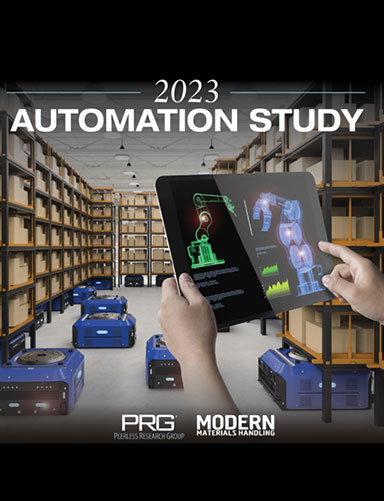Eight in 10 warehouse associates see positive workplaces changes amid labor shortage
According to a new Zebra study, 92% of warehouse associates agree on some level that technology advancements will make the warehouse environment more attractive to workers
Zebra Technologies Corporation, a provider of digital solutions, hardware and software including mobile devices and mobile robotics, recently conducted a new global Warehousing Vision Study to explore the trends and sentiments driving operational decisions and spend in warehouses. The findings released today deliver encouraging news, Zebra concluded: warehouse operators are making significant investments to better fulfill the needs of both customers and workers and make it easier to fill open jobs.
Nearly nine in 10 warehouse operators agree they must implement new technology to be competitive in the on-demand economy, with 80% confirming the pandemic has prompted them to evolve and modernize more quickly, Zebra found. They’re turning their focus and spending most heavily toward technologies that support workforce augmentation and workflow automation. For example, the use of wearables, mobile printers and rugged tablets will increase in the next few years, along with mobile dimensioning software that automates parcel and carton measurements. Additionally, 27% of warehouse operators have already deployed some form of autonomous mobile robots (AMR) today. Within five years, that number is expected to grow to 90%.
“We’re seeing a positive shift occurring in the supply chain and, specifically, within warehouses,” said Mark Wheeler, Director of Supply Chain Solutions, Zebra Technologies. “Most decision-makers believe investments in automation far outweigh the risk of doing nothing, and they are becoming more comfortable integrating all sorts of new technologies into their current operations and infrastructure.”
Warehouse associates are also becoming more comfortable with their employers’ use of advanced technologies. Less than half (45%) say their employers have increased wages or offered bonuses amid labor constraints, yet most (82%) feel positively impacted by the situation. Employers are improving work conditions in other ways, such as giving them more technology to use on the job and leveraging technology to create more flexible work shifts. In fact, an overwhelming 92% of warehouse associates agree on some level that technology advancements will make the warehouse environment more attractive to workers, even in times like these when supply chains are strained, demand is surging, and there’s increasing pressure to meet tighter deadlines, Zebra found.
Decision-makers are having a harder time getting customer orders out the door on time than they did three years ago, and they’re struggling to maintain inventory accuracy and visibility. They also admit they’re expected to deliver orders faster than ever to keep up with the on-demand economy, with rising transportation costs taking their toll on over 40% of warehouse operators spanning manufacturing, transportation, wholesale distribution, logistics and retail. This may not be surprising when you consider that respondents indicate their shipping volumes have increased more than 20% on average over the past two years.
Like associates, though, warehouse operators are viewing these challenges as catalysts for change and growth. Between now and 2025, over eight in 10 expect to increase the number of stock-keeping units (SKU) they carry and the volume of shipped items. They also plan to expand returns management operations, offer more value-added services, and increase their physical footprints, with both the number and size of warehouses increasing.
While 61% of warehouse operators also want to increase headcount within the next year to right-size their workforces, they admit finding and training workers in a timely manner remain big challenges. As a result, over eight in 10 decision-makers agree they will have to rely more on automation in the future.
While most warehouse operators will deploy AMRs for person-to-goods (P2G) picking, material movements and other automated inventory moves, more will invest in software that helps automate analytics and decision-making. They want to raise worker effectiveness and efficiency and reduce labor costs.
“As the pace of operations accelerates and workflows become more complex, warehouse operators have found the average time to get workers to full productivity is 4.7 weeks,” said James Lawton, Vice President and General Manager, Robotics Automation, Zebra Technologies. “Right now, decision-makers feel the most important labor initiative is to reduce unnecessary tasks so associates can focus on more customer-centric work. If warehouse operators automate through AMRs and workflow optimization software, it will be easier to scale operations and meet service level agreements as customer demands and labor availability fluctuate.”
With warehouse operators planning to increase automation, some might say jobs will be lost. Yet, study respondents believe automation may help keep more people in their jobs and fill empty ones, according to Zebra’s take on the study. For example, nearly eight in 10 warehouse associates say walking fewer miles per day would make their jobs more enjoyable, even if they had to pick or handle more items, and many strongly believe AMRs could make warehouse jobs less stressful.
Decision-makers should take note, Zebra noted, since only 41% completely agree implementing warehouse technologies such as robotics and devices can help attract and retain workers, even though the study found that most associates who work alongside AMRs confirm they have helped increase productivity and reduce walking/travel time (83%), reduce errors (73%), and enable advancement to new roles or opportunities (65%). Additionally, 83% of associates claim they are more likely to work for an employer that gives them modern devices to use for tasks versus an employer that provides older or no devices (83%). Other findings are found in this infographic.
In an interview with Modern about the study, Wheeler said management can use that positive attitude toward technology among frontline workers as a recruitment and retention advantage.
“If you are making investments in technology that are making jobs easier for employees and are intuitive to learn and use, that is going to help you out, in attracting and retaining the labor you need to run the business,” Wheeler said.
While there clearly is progress in uptake around AMRs and other productivity-boosting technologies, Wheeler adds that the industry as a whole still hasn’t tapped the full potential of real-time, sensor-based visibility over physical processes in warehouses, as well as software that can automatically adapt operations based on that visibility. “I believe it’s a journey we are on as an industry, and that it is somewhat slow in coming,” said Wheeler. “We need to lean more heavily into sensors.”
Regional highlights from the survey included:
• Asia Pacific: Nine in 10 APAC decision-makers agree machine vision and/or fixed industrial scanning technology in key areas would save time and eliminate errors, even though only one-quarter are currently using them.
• Europe: EMEA warehouse associates were the most likely to say they would view their employer more positively if provided with mobile devices and technology (85%).
• Latin America: 96% of associates in LATAM believe implementing warehouse technologies such as robotics and devices would help attract and retain workers, the highest of any region.
• North America: 86% of North American decision-makers say the pandemic has prompted them to evolve and modernize more quickly, the most of any region.













